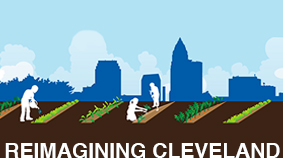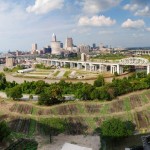
Re-Imagining Cleveland
Urban farming is taking hold in Cleveland and other de-industrialized cities in the US as vacant lots are being repurposed into ways for the local community to prosper. In fact, Cleveland has been ranked as the second best local-food city in the United States by SustainLane, a San Francisco based green media company.
Urban farming, as a form of Green Infrastructure, is not only helping to feed those in the city of Cleveland, it is helping to grow the local economy too. A report, The 25% Shift, finds that increasing local food production to 25%, could add as many as 27,664 new jobs. If the 25% shift can be achieved the local tax base could increase by $126 million and the annual regional output could increase by $4.2 billion.
There are over 3300 acres of vacant land throughout the city of Cleveland. Programs such as the City of Cleveland’s Landbank Program, the Cuyahoga County Land Reutilization Corporation, and the City of Cleveland’s Industrial-Commerical Land Bank are helping residents acquire land at little to no cost. Land not suitable for building can be used for yard expansion, community gardening, urban farming, and park development (NORSD).

Ohio City Farm
Urban farming will help to increase the quality of life for Cleveland’s inhabitants across the sustainability spectrum – economically, socially, and environmentally. These productive landscapes will stimulate economic development as neighborhoods can acquire vacant lots to grow their own food and sell the excess. Community Supported Agriculture (CSA’s) provide stable income for farmers and provide consumers with fresh in-season produce throughout the growing season. Local food advocates are promoting the idea of supplying at least 25% of the food locally to Northeast Ohio. Currently, local food efforts supply only 1-5% of the food market, however the jump to 25% of the region’s $10 billion food market would significantly stimulate the local economy generating many needed jobs. Through the program ReImagining Cleveland, Neighborhood Progress, Inc., is partnering with multiple urban farms and The Cleveland Hostel to provide internship opportunities to learn about urban farming.
Urban farming is a testament to the multi-functional nature of green infrastructure. Urban farming will also help Cleveland achieve its overall goal of managing stormwater runoff by creating more pervious surfaces within the city. Neighborhood development groups and Cleveland Urban Design Collaborative have worked to map urban farming and community garden lots showing the lot relationship to core development areas, other existing vegetation, impervious surfaces, surface water and watersheds, soils, and any known environmental contamination. Planning using mapping techniques will enable designers to maximize green infrastructure projects and overall connectivity. Mapping urban gardening sites can also identify the best locations for neighborhood hubs for selling and produce pick up, storage, and distribution (Masi, et al, 2010).
Cleveland is a promising rebound community, one that is coming back from blight and tainted neighborhoods reinventing itself through the use of green infrastructure. Urban farming and other GI techniques create better stormwater management, increase neighborhood stability and safety, and provide a local food source. Green infrastructure protects our ecosystem services by increasing habitat for local fauna within our urban areas, in turn increasing pollination of urban farm crops.
Sources Cited:
Brad Masi, Schaller Leslie, and Shuman Michael H. December 2010. THE 25% SHIFT The Benefits of Food Localization for Northeast Ohio & How to Realize Them. Sourced 11/25/12: http://www.gcbl.org/files/resources/the25shift-foodlocalizationintheneoregion.pdf
